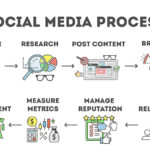In the ever-evolving marketing landscape, businesses constantly seek the most effective strategies to attract customers and drive sales. Two primary approaches have emerged at the forefront of this quest: inbound and outbound marketing. Each strategy offers unique advantages and challenges, and understanding their differences and how they can be integrated is crucial for any successful marketing campaign. This article delves into the essence of inbound and outbound marketing, providing a comprehensive matrix for comparison and exploring the role of marketing channels in these efforts.
Understanding Inbound and Outbound Marketing
Inbound Marketing: This strategy is akin to a magnet. It’s about creating and sharing content tailored to the interests and needs of your target audience. The goal is to attract potential customers to your website or social media platforms, engage them with high-quality content, and convert them into loyal customers. Inbound marketing is customer-centric, providing value and building relationships over time.
Outbound Marketing: Think of outbound marketing as a megaphone. It’s a more traditional form of marketing where businesses push their messages out to a broad audience. This includes advertisements on television, radio, print media, and direct mail campaigns. Outbound marketing is brand-centric, aiming to reach as many people as possible, regardless of their interest in the product or service.
The Matrix of Comparison
The matrix below provides a clear comparison between inbound and outbound marketing across various aspects:
| Aspect | Inbound Marketing | Outbound Marketing |
|---|---|---|
| Definition | Attracting customers through relevant and helpful content. | Reaching out to potential customers through general media and direct contact. |
| Method | Pull marketing – drawing customers in. | Push marketing – sending messages out. |
| Channels | Blogs, SEO, social media, content marketing, opt-in emails. | TV ads, print ads, telemarketing, cold calling, email blasts. |
| Customer Approach | Customer-centric. | Brand-centric. |
| Communication | Interactive and two-way. | One-way. |
| Target Audience | Specific and targeted. | Broad and less targeted. |
| Intent | To educate and engage. | To advertise and promote. |
| Cost | Lower over time. | Higher upfront. |
| Measurement | Direct metrics (engagement, conversion). | Indirect metrics (reach, impressions). |
| Examples | Blogging, SEO, social media engagement. | TV commercials, print ads, direct mail. |
The Role of Marketing Channels
Marketing channels are the mediums through which businesses communicate their message to the audience. Each channel has its strengths and can be leveraged differently in inbound and outbound marketing efforts.
- Blogs and SEO (Inbound): These channels are ideal for attracting users actively searching for information or solutions. By creating valuable content that ranks well in search engines, businesses can draw in a targeted audience.
- Social Media (Inbound): Platforms like Facebook, Instagram, and LinkedIn allow businesses to engage with their audience, share content, and build community, fostering long-term relationships.
- TV Ads and Print Media (Outbound): These traditional channels are effective for reaching a broad audience, making them suitable for brand awareness campaigns, albeit at a higher cost.
- Email Marketing: This channel serves both inbound and outbound strategies. Opt-in emails are used in inbound marketing to nurture leads, while email blasts can be used in outbound marketing to reach a wider audience.
Integrating Inbound and Outbound Marketing
The most effective marketing strategies often involve a mix of both inbound and outbound techniques. By aligning these strategies, businesses can maximize their reach and engagement. For example, content created for inbound marketing can be promoted through outbound channels to extend its reach. Conversely, feedback and data from outbound marketing campaigns can inform and refine inbound marketing efforts.
Alignment:
- Goal-Oriented: Both strategies ultimately aim to increase brand awareness and drive sales, though their approaches differ.
- Complementary Use: Many businesses use a mix of both inbound and outbound tactics to create a comprehensive marketing strategy.
- Brand Promotion: Both contribute to brand promotion, albeit through different methodologies.
Contrast:
- Cost-Effectiveness and ROI: Inbound marketing tends to be more cost-effective over time, offering a higher ROI through organic engagement, whereas outbound marketing often requires a higher upfront investment with potentially lower ROI.
- Customer Relationship: Inbound marketing builds long-term customer relationships, while outbound marketing primarily seeks immediate results.
- Content vs. Interruption: Inbound marketing relies on creating content that potential customers seek out, while outbound marketing interrupts the audience’s activity to get the message across.
Businesses often find the most success by integrating both approaches in a way that aligns with their goals, market, and customer preferences.
Marketing Channels and Inbound / Outbound Marketing
Navigating the multifaceted world of marketing channels can often feel like deciphering a complex puzzle. Each channel, from websites and email to social media, CRM (Customer Relationship Management), and SEO (Search Engine Optimization), plays a unique role in a brand’s marketing strategy. Understanding how these channels operate within the frameworks of inbound and outbound marketing can empower businesses to craft nuanced, effective strategies that resonate with their audience. Let’s explore the intricacies of these channels and their interplay with inbound and outbound marketing approaches.
Website: The Digital Storefront
Inbound Marketing Role: Websites are the cornerstone of inbound marketing efforts. They serve as a digital storefront where potential customers “walk in” through organic search, referrals, or directed from content such as blogs and social media. An inbound-focused website prioritizes user experience, offering valuable content, easy navigation, and clear calls-to-action (CTAs) to convert visitors into leads.
Outbound Marketing Role: In an outbound context, websites support campaigns by providing a destination for traffic generated through ads or direct marketing efforts. Here, the emphasis might be on landing pages specifically designed to match the messaging of outbound campaigns, aiming for immediate conversions or actions.
Email: The Personal Touchpoint
Inbound Marketing Role: Email marketing, within inbound strategies, focuses on nurturing leads by providing tailored, valuable content based on the recipient’s behavior and preferences. This approach relies on consent-based subscriptions, ensuring that communications are welcomed and anticipated by the audience.
Outbound Marketing Role: Outbound email efforts typically involve sending unsolicited emails to a broad audience. The goal is to introduce the brand or offer directly, hoping to spark interest or prompt an immediate response. This method can be less targeted and often results in lower engagement rates compared to inbound tactics.
Social Media: The Community Hub
Inbound Marketing Role: Social media platforms are vital for inbound marketing, allowing brands to engage directly with their audience, share valuable content, and build community. These platforms facilitate two-way conversations and can amplify the reach of content marketing efforts through shares and interactions.
Outbound Marketing Role: In outbound strategies, social media can be used for targeted ads aimed at demographics that have not yet engaged with the brand. These ads interrupt the user’s social media experience with the hope of capturing their attention and redirecting them to a website or landing page.
CRM: The Relationship Builder
Inbound Marketing Role: CRM systems are integral to inbound marketing for managing and analyzing customer interactions and data throughout the customer lifecycle. They help personalize marketing efforts, track the buyer’s journey, and enhance customer satisfaction by ensuring communications are relevant and timely.
Outbound Marketing Role: For outbound marketing, CRM tools can segment lists for targeted campaigns, manage leads generated from outbound activities, and track the effectiveness of direct marketing efforts, helping to refine strategies and target messaging more effectively.
SEO: The Visibility Enhancer
Inbound Marketing Role: SEO is a purely inbound marketing channel, focused on improving a website’s visibility in search engine results pages (SERPs) to attract organic traffic. It involves optimizing website content, structure, and on-page elements like meta tags, as well as building high-quality backlinks.
Outbound Marketing Role: While SEO itself does not have a direct outbound application, the insights gained from SEO efforts, such as keyword popularity and user intent, can inform outbound strategies, such as the topics or language used in direct advertising campaigns.
How They Work and Contrast
Each channel can be adapted to serve both inbound and outbound strategies but tends to excel in one. For instance, SEO and websites are predominantly inbound tools, focusing on attracting and engaging users with high-quality content and user experiences. Email and social media can swing both ways; they can nurture leads and build community or serve as platforms for broad-reaching ads and direct campaigns. CRM, while a backend tool, supports both by ensuring that customer interactions are tracked and leveraged for both targeted relationship building and broad outreach.
Understanding the nuanced roles of these channels and how they align with or contrast against inbound and outbound marketing principles allows businesses to tailor their strategies effectively. By combining the strengths of each channel and marketing approach, brands can create a holistic strategy that attracts, engages, and delights their audience across every stage of the customer

Since its launch in 2016, Bizbotweb has been at the forefront of empowering businesses and individuals to easily navigate the digital world, from owning their intellectual property to managing websites and simplifying WordPress setups. As the author of our articles, the “Chief Robot” brings a wealth of knowledge and innovation, embodying Bizbotweb’s commitment to making digital presence seamless and accessible for everyone. Focusing on integrated digital marketing efforts, our content is designed to guide users through the evolving digital landscape, ensuring they have the tools and insights needed to thrive online.
Blog Categories
Check out other Pages
Have questions?
Schedule a free consultation if you have questions about our digital marketing services or would like additional information.










